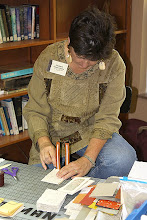Although very little tin is mined in Cornwall today, the disused mines stand as beacons to Cornwall's rich history of mining. While China clay is still mined in Cornwall, many of the clay tips that appeared as white pyramids on the horizon during WWII have since been used for building materials. One of the largest clay pits has been transformed into Eden Project, the largest botanical biosphere gardens in the world.
Eden Project
In May 2005, Peter and I met with Dr. Jo Readman, the Director of Education at Eden Project, when I donated a copy of my research, "Handmade Paper from the Crops of Madison County," to their library. At that time, Eden Project was planning a new exhibition, "Paper Trail," focusing on plants around the globe that might be used in papermaking.
Dr. Jo Readman and Elizabeth at Eden Project's Research Library
Tin Mines and China Clay
Tin Mines and China Clay (detail during construction)
Inspired by the Cornish landscape and knowledge gained through my plein air abstract paintings of Cornwall coastlines, my latest handmade paper constructions were created with flax and abaca paper pigmented, dyed, stitched and textured in the elements of coastal paths, pebbled beaches, disused tin mines that travel deep into the earth and out under the Atlantic, china clay mines that erupt from the landscape, brightly colored fishing boats, windswept moors and the ever-changing atmosphere of the sea.
From Sea to Moors to Sea (new title)
Four of my handmade paper constructions will be on display, along with the five tidal pool paintings, at tonights opening of E.L.E.M.E.N.T.S. at Main Street Art Gallery in Edwardsville, IL from 6-8pm. The exhibition runs July 23 through August 28, 2010.







the ancient Romans, visited Cornwall for their tin mines and other minerals. China clay, or kaolin, was discovered in Cornwall in 1746 by William. While China clay is still mined in Cornwall, many of the clay tips that appeared as white pyramids on the horizon during WWII have since been used for building materials.
ReplyDeletehttp://www.manekgroup.net/
Thanks for your comment. Although we can no longer see the china clay tips of the past, except for those covered in vegetation, my husband remembers the shining mica and sand tips of his childhood in the St. Austell area.
ReplyDelete